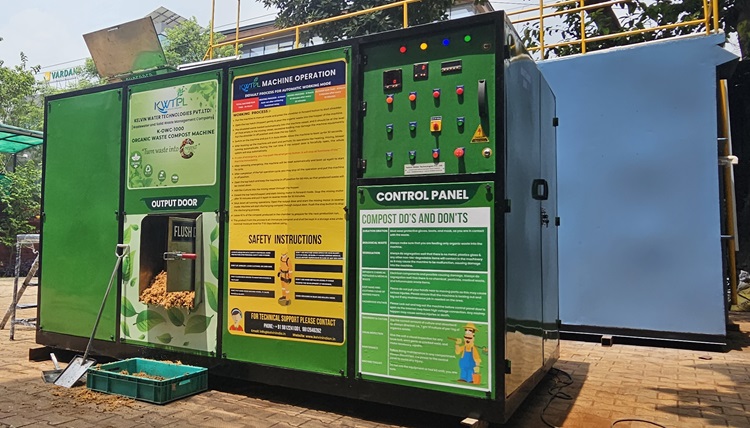Food Waste Composter and Its Work Process

A food waste composter is a device designed specifically to handle and process food waste through a composting mechanism, converting kitchen scraps into nutrient-rich compost. The goal is to divert food waste from landfills, where it would contribute to greenhouse gas emissions, and instead utilize it in an environmentally friendly manner.
Key features and components of a Food Waste Composter may include:
- Design and Size: Food waste composters come in various sizes and designs. They can range from small countertop units suitable for residential kitchens to larger units designed for commercial or institutional use.
- Chopping or Grinding Mechanism: Some food waste composters have built-in mechanisms to chop or grind food scraps into smaller pieces. This increases the surface area of the waste, promoting faster decomposition.
- Aeration System: Proper aeration is essential for the composting process. Many food waste composters have systems to allow air circulation, and some may even include automated turning mechanisms.
- Microbial Inoculation: Some composters may come with microbial additives or accelerators. These additives introduce beneficial microorganisms to kickstart and enhance the composting process.
- Odor Control: Odor can be a concern with food waste composting. Many composters include features to control or minimize odors, such as filters or airtight seals.
- Temperature and Moisture Control: Like other composters, food waste composters benefit from maintaining optimal temperature and moisture levels. Some units may include temperature and moisture sensors or controls to ensure ideal conditions for composting.
- Ventilation System: Proper ventilation is crucial to prevent the buildup of gases during composting. Some composters have built-in ventilation systems to facilitate the release of gases produced during the decomposition process.
- Timer or Automated Controls: Certain food waste composters come with automated controls or timers, allowing users to set specific composting cycles. This can be particularly useful for larger or more advanced composting systems.
- Maturation Stage and Harvesting: Once the composting process is complete, the mature compost can be harvested. Some composters have mechanisms for easy removal of the finished compost.
Food waste composting machine works:
Collection of food waste:
Users deposit kitchen scraps, food leftovers, vegetable peels, fruit cores, and other organic waste into the food waste composting machine.
Shredding or Grinding (Optional):
Some composting machines include a shredding or grinding mechanism that breaks down the food waste into smaller particles. This increases the surface area of the waste, facilitating faster decomposition.
Related: Organic Waste Composter
Microbial Inoculation (Optional):
Some machines may have a microbial inoculation system, introducing beneficial microorganisms (such as bacteria and fungi) to jumpstart the composting process.
Aeration:
Adequate aeration is essential for composting. Food waste composting machines often have aeration systems, which may involve turning mechanisms or ventilation to ensure a continuous supply of oxygen to the composting material.
Temperature and Moisture Control:
Maintaining optimal temperature and moisture levels is crucial for efficient composting. Composting machines may have controls or sensors to monitor and adjust these factors during the composting process.
Composting Chambers or Bins:
The composting machine typically consists of chambers or bins where the composting process takes place. The design allows for the separation of different stages of composting if the machine has multiple compartments.
Microbial Activity and Decomposition:
Microorganisms naturally present in the organic waste or introduced through microbial inoculation break down the complex organic compounds into simpler substances. This decomposition process generates heat as a byproduct.
Maturation Stage:
After a certain period, the composting material reaches a maturation stage. This stage is characterized by the completion of the composting process, resulting in a stable and nutrient-rich compost.
Harvesting:
The mature compost is ready for harvesting. Some composting machines have mechanisms for easy removal of the finished compost. Users can then collect the compost for use in gardening, landscaping, or other applications.
Odor Control:
Many food waste composting machines include features to control odors. This may involve the use of filters or airtight seals to prevent unpleasant smells from escaping during the composting process.
Related: Importance of STP Plant For Kitchen
Benefits of Food Waste Composter Machine
- It reduces the volume of waste sent to landfills. This helps divert significant amounts of organic material away from traditional waste disposal methods.
- A composting machine provides essential nutrients for plant growth, reducing the need for chemical fertilizers.
- It minimizes the production of methane, a potent greenhouse gas that is released when organic waste decomposes in landfills.
- Nutrient-rich compost produced can be used to improve soil health, potentially reducing the need for expensive commercial fertilizers.
- Composting machines are designed to manage and control odors associated with the decomposition of organic waste.
- They allow for on-site composting, reducing the need for large waste storage areas and minimizing transportation requirements.
- Composting machines come in various sizes, from small household units to larger commercial or industrial systems. This scalability allows individuals and businesses to choose a composting solution that matches their specific needs.







